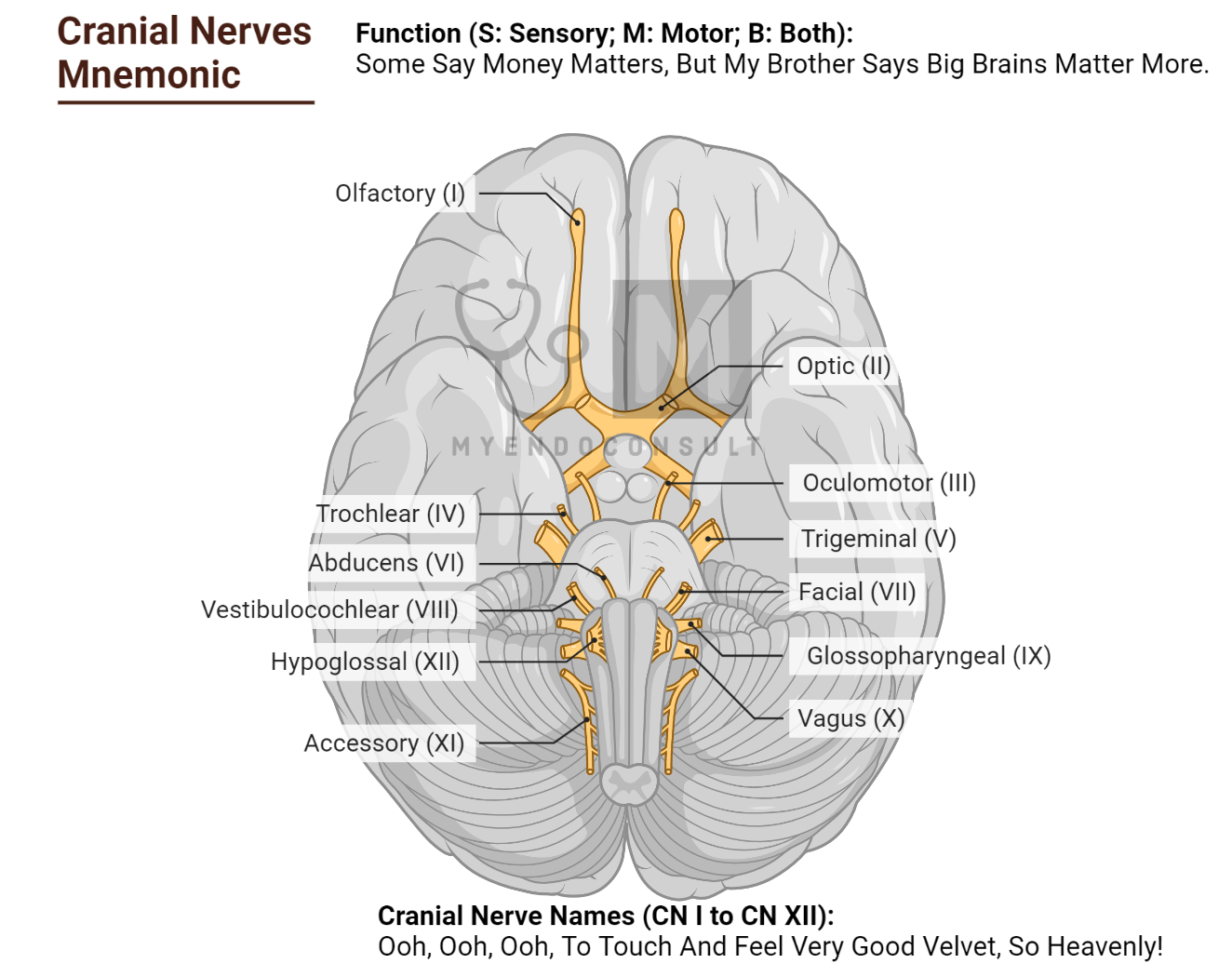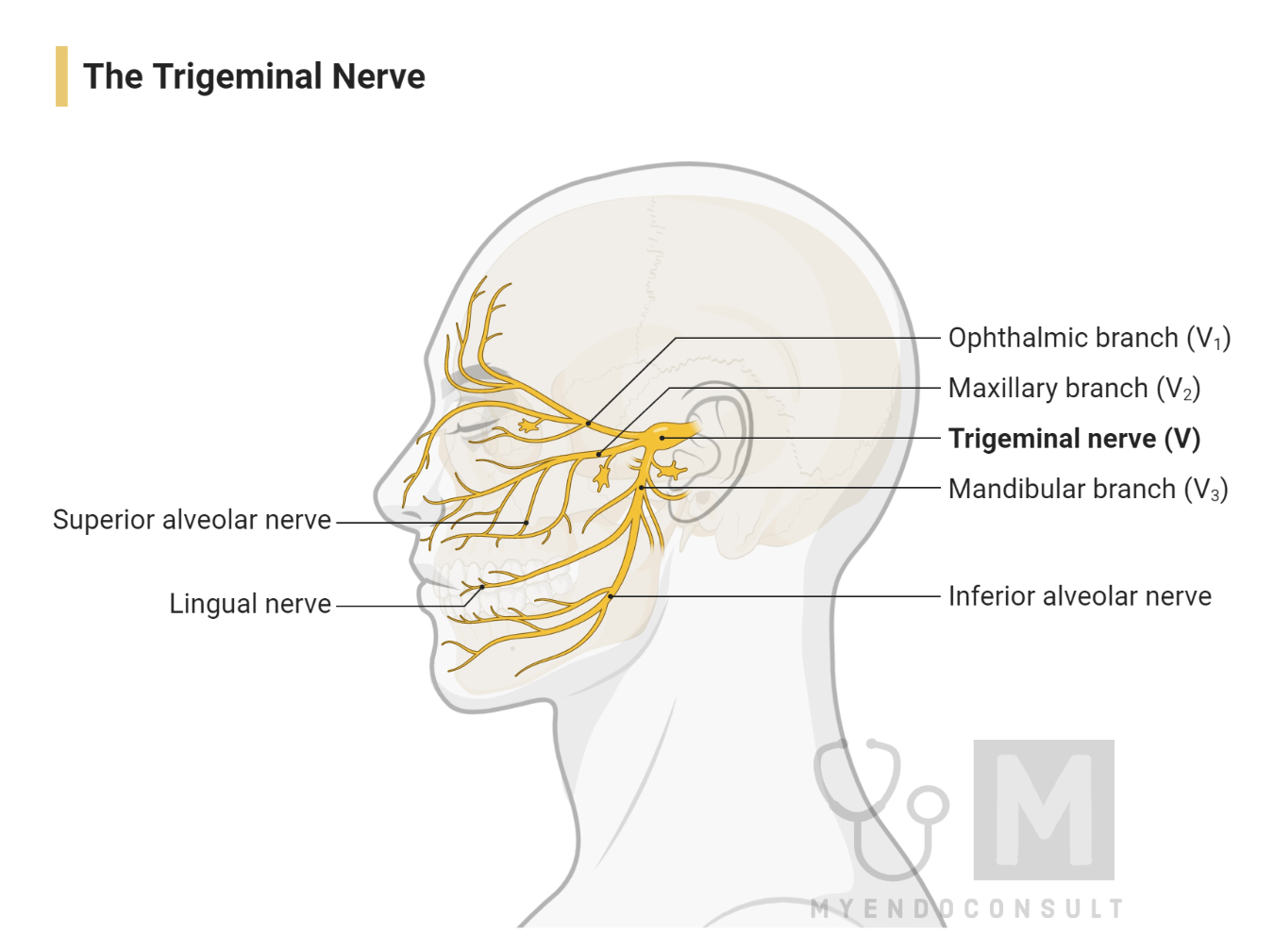Hey medical students, here's a fun and intuitive way to remember the 12 cranial nerves and their sensory or motor functions! We have two catchy mnemonics that'll help you ace your exams.
Cranial Nerve Names (CN I to CN XII):
Ooh, Ooh, Ooh, To Touch And Feel Very Good Velvet, So Heavenly!

Here's a brief overview of the 12 cranial nerves and their clinical courses:
Olfactory nerve (CN I): The olfactory nerve is responsible for the sense of smell. It originates in the olfactory epithelium in the nasal cavity and passes through the cribriform plate of the ethmoid bone to synapse in the olfactory bulb.
Optic nerve (CN II): The optic nerve is responsible for vision. It originates from the retinal ganglion cells in the retina of the eye and passes through the optic canal to form the optic chiasm, where some nerve fibers cross over to the other side. The optic tracts then continue to the lateral geniculate nucleus in the thalamus, eventually synapsing in the primary visual cortex in the occipital lobe.
Oculomotor nerve (CN III): The oculomotor nerve controls most of the eye muscles (except for the lateral rectus and superior oblique) and is responsible for eyelid elevation, pupil constriction, and lens accommodation. It originates in the midbrain and passes through the superior orbital fissure to reach the orbit.
Trochlear nerve (CN IV): The trochlear nerve controls the superior oblique muscle of the eye, allowing for downward and inward eye movements. It originates in the midbrain and passes through the superior orbital fissure to the orbit.
Trigeminal nerve (CN V): The trigeminal nerve is responsible for facial sensation and the motor function of the muscles of mastication. It has three branches: ophthalmic (V1), maxillary (V2), and mandibular (V3). It originates in the pons, and its branches pass through the superior orbital fissure (V1), foramen rotundum (V2), and foramen ovale (V3) to reach their respective target areas.

Abducens nerve (CN VI): The abducens nerve controls the lateral rectus muscle of the eye, enabling outward eye movement. It originates in the pons and passes through the superior orbital fissure to the orbit.
Facial nerve (CN VII): The facial nerve is responsible for facial expression, taste sensation in the anterior two-thirds of the tongue, and some functions of the salivary and lacrimal glands. It originates in the pons, passes through the internal acoustic meatus, and exits the skull through the stylomastoid foramen.
Vestibulocochlear nerve (CN VIII): The vestibulocochlear nerve is responsible for hearing and balance. It consists of two parts: the cochlear nerve for hearing and the vestibular nerve for balance. It originates in the inner ear and passes through the internal acoustic meatus to the brainstem.
Glossopharyngeal nerve (CN IX): The glossopharyngeal nerve is responsible for taste sensation in the posterior third of the tongue, sensation in the upper pharynx, and some functions of the parotid gland. It also plays a role in regulating blood pressure and respiration. It originates in the medulla and exits the skull through the jugular foramen.
Vagus nerve (CN X): The vagus nerve is a mixed nerve that innervates the pharynx, larynx, esophagus, trachea, heart, and various abdominal organs. It controls functions such as swallowing, speech, heart rate, and gastrointestinal activity. It originates in the medulla and exits the skull through the jugular foramen.
Spinal accessory nerve (CN XI): The spinal accessory nerve controls the sternocleidomastoid and trapezius muscles, which are responsible for head and shoulder movement. It has two parts: the cranial part, which originates in the medulla, and the spinal part, which originates in the upper spinal cord. The spinal part ascends through the foramen magnum and joins the cranial part. The combined nerve then exits the skull through the jugular foramen and innervates the target muscles.
Hypoglossal nerve (CN XII): The hypoglossal nerve controls the intrinsic and extrinsic muscles of the tongue, which are important for speech, swallowing, and manipulating food. It originates in the medulla and exits the skull through the hypoglossal canal.
In clinical practice, assessment of cranial nerve function is an essential part of the neurological examination. Damage or dysfunction of one or more cranial nerves can result from various causes, including trauma, tumors, infections, and neurodegenerative diseases. Identifying cranial nerve deficits can help localize the lesion and guide further diagnostic and therapeutic interventions.
Function (S: Sensory; M: Motor; B: Both):
Some Say Money Matters, But My Brother Says Big Brains Matter More.
Here's an outline of the sensory and motor functions of the 12 cranial nerves:
Olfactory nerve (CN I)
- Sensory: Smell
Optic nerve (CN II)
- Sensory: Vision
Oculomotor nerve (CN III)
- Motor: Eye movement (innervates the superior, inferior, and medial rectus muscles, and the inferior oblique muscle); Eyelid elevation (levator palpebrae superioris); Pupil constriction (sphincter pupillae); Lens accommodation (ciliary muscle)
Trochlear nerve (CN IV)
- Motor: Eye movement (innervates the superior oblique muscle)
Trigeminal nerve (CN V)
- Sensory: Facial sensation (ophthalmic, maxillary, and mandibular branches)
- Motor: Muscles of mastication (temporalis, masseter, medial and lateral pterygoids)
Abducens nerve (CN VI)
- Motor: Eye movement (innervates the lateral rectus muscle)
Facial nerve (CN VII)
- Sensory: Taste sensation (anterior two-thirds of the tongue)
- Motor: Facial expression (muscles of facial expression); Secretory function (lacrimal, submandibular, and sublingual glands)
Vestibulocochlear nerve (CN VIII)
- Sensory: Hearing (cochlear branch); Balance and spatial orientation (vestibular branch)
Glossopharyngeal nerve (CN IX)
- Sensory: Taste sensation (posterior third of the tongue); Sensation in the pharynx, tonsils, and the middle ear
- Motor: Swallowing (stylopharyngeus muscle); Secretory function (parotid gland)
Vagus nerve (CN X)
- Sensory: Sensation from the pharynx, larynx, esophagus, trachea, heart, and various abdominal organs
- Motor: Swallowing (pharyngeal muscles); Speech (intrinsic laryngeal muscles); Parasympathetic function (heart, lungs, and gastrointestinal tract)
Spinal accessory nerve (CN XI)
- Motor: Head and shoulder movement (innervates the sternocleidomastoid and trapezius muscles)
Hypoglossal nerve (CN XII)
- Motor: Tongue movement (innervates the intrinsic and extrinsic muscles of the tongue)
Putting it all together
Here's how they align:
Ooh, Ooh, Ooh, To Touch And Feel Very Good Velvet. So Heavenly!
Some Say Marry Money, But My Brother Says Big Brains Matter More.
Olfactory nerve (CN I): S
Optic nerve (CN II): S
Oculomotor nerve (CN III): M
Trochlear nerve (CN IV): M
Trigeminal nerve (CN V): B
Abducens nerve (CN VI): M
Facial nerve (CN VII): B
Vestibulocochlear nerve (CN VIII): S
Glossopharyngeal nerve (CN IX): B
Vagus nerve (CN X): B
Spinal accessory nerve (CN XI): M
Hypoglossal nerve (CN XII): M
Just write the mnemonics for names and functions side by side to easily recall both the cranial nerve names and their functions. Happy studying!
Kindly Let Us Know If This Was helpful? Thank You!


